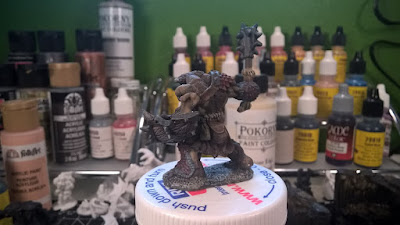Anyway, the first step was to finally get this bugbear I'd been picking at for several months to a finished point. I really used him as a prototype for experimenting with different shade variations based on the same color... in this case, I was working with browns and reds. He was already mostly finished as of this weekend, but I hadn't started any of the metal surfaces on his weapons, shield or armor.
Next, I cracked into my Dwarven Forge cavern set. These tiles are great, because you can be super sloppy with the paint and still get amazing results. I painted one tile to completion to test out my technique, and then got started on an assembly line working through a whole set one step at a time.
Then I decided to attempt a set of several Bones minis at the same time. I stuck a selection of nasty insects onto a popsicle stick, but struggled to keep it steady while base coating... then I stuck the popsicle stick to the top of an old pill bottle and had much better success. Again, I couldn't resist just finishing up one whole mini instead of working through the group... so I painted a scorpion.
My experience this weekend taught me a couple things about my technique. First, I need to load more paint on my brush while base-coating. I had much more success getting the first coat on the scarab beetle than with either of the scorpions, because I was starting with a properly full brush. It resulted in a much smoother edge when free-handing the legs on top of the model's triangular leg slab things. On a related note, I need to not be so stingy with the paint on my pallette. All my paint bottles are dropper style, so I can drip out really tiny amounts, but if it dries or gets clumpy before I finish, then any added efficiency will be lost. Lastly, I really need to thin my shade and highlight layers. The Bones line is a little obnoxious because the plastic repels anything except full-thickness paint, so the base-coat can't be thinned. But thinning the top coats really helps smooth out any blending work.
I still have a few process questions I'm still wrestling with, particularly when it comes to working with Bones. They are advertised as being paintable without priming, and indeed, that is what I did with both the hobgoblin and scorpion, but base-coating black by hand was a real pain and would have been much more quickly done with a rattle can of primer. Unfortunately, I have had some bad experiences with Bones and primer. I found that a hobgoblin similar to the one I just completed remained tacky to the touch for at least several weeks when primed with a Krylon spray can. Spray on clear coat has had a similar effect. I have two Bones candelabras that are still sticky to touch years after painting and sealing with a clear coat. I'm not sure what causes the reaction, but it is something I haven't experienced with pewter models.
The need to use undiluted paint when basecoating unprimed Bones is similarly frustrating. I feel like many of the faces I paint on Bones models wind up looking cakey, and I wonder if it is because the base coat has to be so thick.
Regardless of my outstanding questions, it felt good to make a small dent in my pile of painting. Now if I can just let myself be a relative beginner at this and not try to match the high level of expertise I see in the YouTube videos I've been watching. I may get there, but not if I'm too paralyzed to practice.
The need to use undiluted paint when basecoating unprimed Bones is similarly frustrating. I feel like many of the faces I paint on Bones models wind up looking cakey, and I wonder if it is because the base coat has to be so thick.
Regardless of my outstanding questions, it felt good to make a small dent in my pile of painting. Now if I can just let myself be a relative beginner at this and not try to match the high level of expertise I see in the YouTube videos I've been watching. I may get there, but not if I'm too paralyzed to practice.






